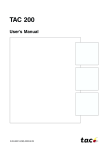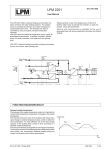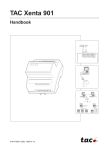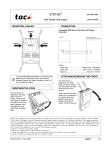Download TAC 200 OTP User`s manual
Transcript
TAC 200 OTP 0FL-3563-000 Heating controller with outdoor reset User’s Manual Mounting Base plate TAC 200OTP Cover Controller TAC 200 OTP TAC 200 OTP is encased in a plastic enclosure with a transparent cover. The controller can be mounted in three ways, either directly on the wall, on a DIN rail or in a panel. There are cable inlet holes on three sides. The controller is attached to the base and should be removed as in figure 1. Mount the base plate in an easily accessible position where the display is clearly legible. Connect the wires according to the wiring diagram. Screw the controller back onto the base plate. There are holes in the base plate for mounting the controller directly onto the wall if preferred. To mount the controller on a DIN rail, see figure 2, place the controller on the upper edge of the rail and press it inwards to snap it into place. To remove it again, place a screw driver in the red piece of plastic on the lower part of the controller, pull downwards and then pull the controller upwards from the rail. Figure 1 To mount the controller in a panel the space needs to be 138×92 mm. Place the controller in the panel and turn the small plastic hooks in the controller’s screw holes to secure it. Outdoor sensor EGU Mount the sensor on an external wall, facing north or northwest. The sensor should be placed about 3 m above ground level and the cable inlet should face downwards. DIN rail Supply sensor EGWS/EGA The immersion sensor EGWS is mounted in the riser pipe, some 0,5–1 m downstream of the mixing valve. If an EGA strap-on sensor is used, it should be mounted on an uninsulated part of the pipe. Clean the pipe thoroughly so that the copper contact plate of the sensor makes good contact with the pipe. Figure 2 Room sensor EGRL To achieve the best performance, the following should be taken into consideration when mounting the room sensor: • The sensor should be installed in a room which is typical of the building. • The sensor should be placed on an inner wall of light building material. The wall must not beheated by, for example, uninsulated heating pipes behind it. • The room should be of sufficient size for the temperature not to be adversely affected by people or machinery. • The radiators in the room should not have thermostat valves. If they have they should be turned to the largest value possible. • The room sensor should be placed so that the air can flow freely around it. • The room sensor should be placed within 10 m from the nearest radiator, but not right above it. Wiring Connect the cables to the controller according to the wiring diagram, see figure 3 on the next page. The wires from the controller are connected between inputs 1 and 2 on the room sensor. Length of cables To terminals B1–B3, and X1–X3: Max. 200 m, area 0,5 mm2. To other terminals: Max. 100 m, area 1,5 mm2. Actuator (M44, M5, M15, M42) Mounting instructions are supplied with the actuator/ mounting kit. 0FL-3563-000, 2000-01 1 (4) 3. Switch on power. 4. Set current time and date, see the next page. 230 V/L 1 L M 10 230 V/N 2 N B1 11 3 PE B2 12 Outdoor sensor 4 KC1 B3 13 Room sensor 5 K1 M 14 6 K2 X1 15 R M15/ M44 B Supply temp. sensor 5. Put the brief instruction back in its place. TAC 200 OTP will now control, using the factory settings. To set values other than those set at the factory, refer to the TAC 200 OTP Handbook, part number 0-004-1400. Forced day op. (230 V) W 7 KC2 X2 16 Pump 8 K3 X3 17 Boiler 9 K4 M 18 230 V/L 1 L 230 V/N 2 N Forced night op. Brief instruction Display 3 PE / 4 KC1 Stage 1 Stage 2 P 5 K1 – + P 6 K2 TAC 200 7 KC2 Pump 8 K3 Boiler 9 K4 DIP switches Buttons Figure 4 Terminal board connections 1 2 3 4 5 6 7 8 9 10 11 12 13 14 15 16 17 18 230 V/L 230 V/N PE KC1 K1 K2 KC2 K3 K4 Mains, phase (live) Mains, neutral Protective earth Power supply, relays K1 and K2 Relay K1: increase/stage 1 Relay K2: decrease/stage 2 Power supply, relays K3 and K4 Relay K3: circulating pump Relay K4: boiler M B1 B2 B3 M X1 X2 X3 M Measurement neutral Supply sensor, EGWS/EGA Outdoor sensor, EGU Room sensor, EGRL Measurement neutral Input, forced day operation Input, forced night operation Not in use Measurement neutral 1 2 1. Check that sensors and actuators are correctly wired. 2. Set the switches on the DIP switches on the circuit board, located under the brief instruction, as required, see figure 4 and 5. 5 6 7 8 off (0) Factory setting, 1–8: 1000 000 P:nn in the display indicates the current function used, see figure 6. P:00, for example, means time of day and operating mode. P + P Use these buttons to move up and down the list. – Use these buttons to increase or decrease the value shown on the display. Keep either of them depressed to increase the stepping speed. Use this button to change between day and night in segments of 30 minutes. To save alterations, press P or again. Failure to carry P out this step will result in the changes not being saved and the controller reverting to the old value in approximately two minutes. 7 8 9 10 11 12 13 14 15 16 17 18 6 Switch Position off (0) Position on (I) 1 on/off control mixing valve 2 radiator system floor heating 3 no room sensor installed room sensor 4–7 (no function) 5 (hardware reset when switched 0–1–0) MO TU 3 P:00 2 1 WE TH FR SA SU 19 4 0 8 Figure 5 Operator’s panel / After the controller has been mounted and the electrical wiring is completed, the following checks should be carried out and the settings entered before operation of the installation. 4 on (1) Figure 3 Commissioning 3 K4 12:34 AM °C Ι ΙΙ 20 21 22 23 24 Figure 6 Switches 4–8 should be in the off position. 2 (4) 0FL-3563-000, 2000-01 Setting time and date Setting time program 1. Press The digital clock has a time program, which is used for switching between day and night temperature. All times can be set individually for every day of the week, with a resolution of 30 minutes. The segments—each is 30 minutes long—on the 0–24 scale show when day and night temperature are used, starting with Monday (MO displayed). A black segment denotes day temperature setpoint and a white one night. P or P , until P:13 (Set time) is displayed. 2. Press either + or – until the controller shows current time, e.g. 09:45. Keeping the button depressed increases the stepping speed. 3. Press P , so that P:14 (Day.Month) is displayed. 1. Press 4. Press + or – until the controller shows current date e.g. 29.11. 5. Press P – until the controller shows current year, e.g. 1994. P so that P:00 (Time) is displayed. The time P or P is not pressed as the last step, any changes will not be stored (applies to all entries). In this case the display will automatically revert to P:00 in about two minutes. Note! TAC 200 OTP automatically switches to and from daylight saving time, even in leap years. The dates for change over can be set manually if desired. Current temperatures 1. Press P or P , to display P:01, P:02, P:03 or P:04. P:01 room temperature (if a room sensor is installed) P:02 outdoor temperature P:03 supply water temperature P:04 supply water temperature setpoint P 4. If you press + , and you are at the last segment, the segment and press – , the display changes to the previous day. 5. Mark all the segments of all day-and-night periods as desired. 6. Use the same procedure to mark the segments for each day of the week. 7. Store the changes by pressing P or P at least once. If the same pattern for day/night setpoint is required for several days, either repeat the above or, for speed, use P:09 (Time program, 1–7 days). The days of the week and the 0–24 segments can then be changed in the same procedure. P or P until P:09 (Time program, 1–7 days) is displayed. 3. Press / – until the first day to be removed flashes. . The marked day disappears. 4. Remove all the days for which the change should not apply in the same way. Make sure that the days to which the changes apply, are visible on the display. 5. The flashing weekday indication will automatically skip to the segments of 30 minutes when passing either Sunday or Monday (in reverse direction). Setting temperature setpoint or – until you reach the segment you want to 3. Press / . The colour of the segment changes and the flashing skips to the next segment. 2. Press + or 2. The current value is continually updated, but after about two minutes the display reverts to P:00 (Time/Operating mode). P until P:08 (Time program, day-by-day) change. The segment flashes. 1. Press Function displays current 1. Press P display changes to the following day. If you are in the first value is now stored. If or 2. Press + or so that P:15 (Year) is displayed. 6. Press + or 7. Press P is displayed. to display P:05, P:06 or P:07. 6. When day setpoint is required, mark the segments in the same way as above. or to save the changes. Function displays 7. Press P:05 8. To set other times for other days, return to P:09 and repeat steps 2–7 for these days. room temperature setpoint (°C) (with room sensor) P:06 night setback (°C) (with room sensor) P:07 parallel shift of reset curve (°C) (without room sensor). P P Note! Take care as this operation changes several days at the same time. 2. Press + or – until the display shows desired value. Keeping the button depressed increases the stepping speed. 3. Store changes by pressing 0FL-3563-000, 2000-01 P or P at least once. 3 (4) To change operating mode Power failure The temperature of the building can be lowered for a longer period of time, e.g. if it is empty during a holiday, or if the day temperature is required for a couple of hours extra one night, without changing the TAC 200 OTP program. The controller can also provide day or night temperature all the time or be turned off without losing the settings. The controller maintains the settings for at least twelve hours during a power failure. The clock keeps running and when the power returns, the controller continues to control the system as if nothing had happened. Should the power failure last longer than twelve hours, the time, date and year will require re-setting. It is possible to toggle between the following operating modes on the operator’s panel: Restart Forced off If the controller has stopped working, it may need to be restarted. To do this switch DIP switch 8, behind the brief instruction on the front of the controller, to on and then back to off. All the settings remain in the controller. Forced night operation Automatic operation (control by the time program) To restart the controller and regain the factory settings: Forced day operation 1 Press P and During forced off, the controller is turned off without loosing the settings. 2 Press P or During forced night operation the controller provides night temperature all the time. In the same way, the controller provides day temperature all the time during forced day operation. 3 Press + . During automatic operation, the controller provides day and night temperature according to the programmed settings. P P to reach P:16. until P:54 is shown on the display. Accessories TAC 200 OTP Handbook, part number 0-004-1400. To change the operating mode: 1. Press P or P until P:00 (Operating mode) is displayed (if it is not already shown). 2. Press + or – until the desired symbol is activated. If forced day or night operation has been activated from outside the controller (Extended day/night operation, see the handbook), the corresponding symbol flashes. Externally forced operation (X1, X2) has a higher priority than any locally forced operation. To access other functions Normally it is sufficient to use P:00–P:15 and for this reason the display scrolls through P:15–P:00 or vice versa. To access functions P:16 and higher: 1. Simultaneously press 2. Press P or P P and P to get to P:16. to step up or down within the new interval. To return to P:00–P:15, either press P and P simultaneously, or wait for approximately two minutes for the controller to return to P:00 automatically. Depending on the specific configuration, certain non-relevant functions may be missing. TAC AB, Jägershillgatan 18, SE-213 75 MALMÖ, SWEDEN, +46 40 38 68 50 (vx) 4 (4) English 0FL-3563-000, 2000-01












